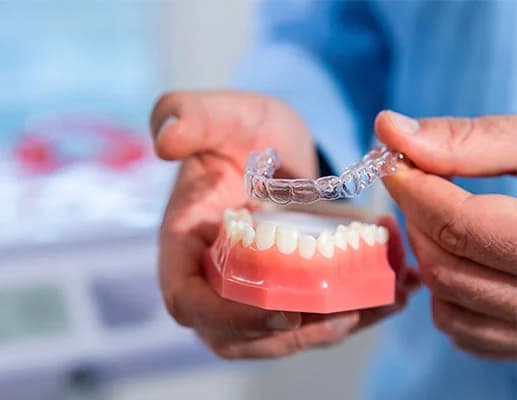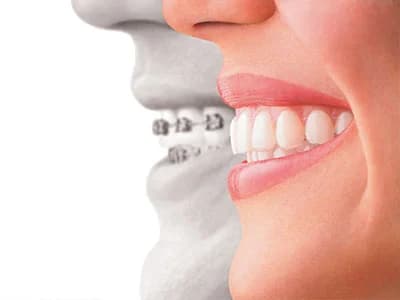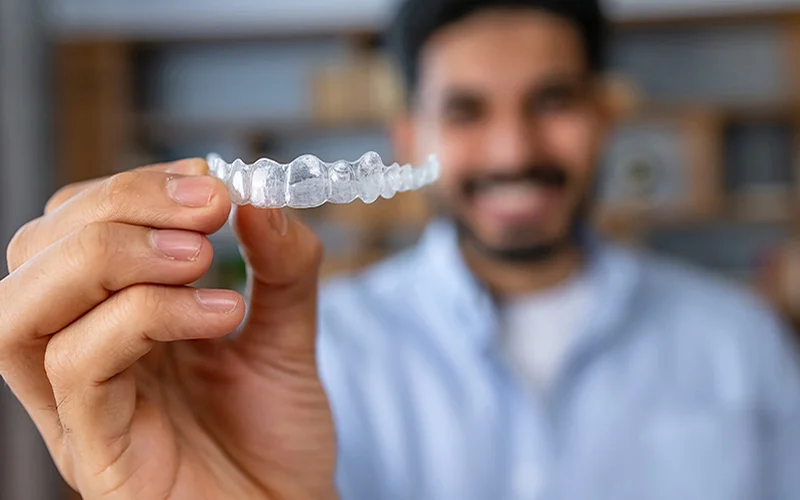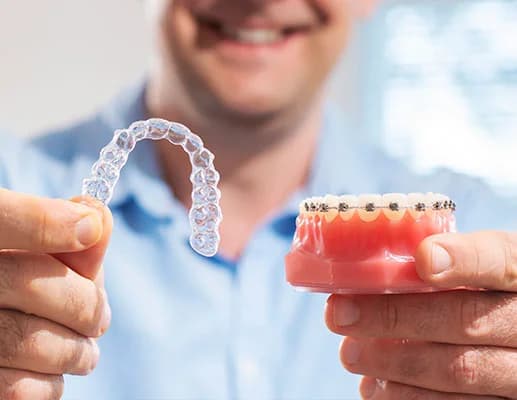Straightening your teeth isn't just about looks—it can improve oral health. But which is the better option, Invisalign or braces? According to the American Association of Orthodontists, millions of people in the U.S. wear braces, but clear aligners like Invisalign have become an increasingly popular alternative.
So, how do Invisalign vs braces compare? We'll explain everything you need to know, from cost and comfort to treatment time and effectiveness, so that you can make the best decision for your smile.
Invisalign vs Braces: Understanding the Basics
The two most common options for straightening teeth are Invisalign and traditional braces. Both treatments gradually shift teeth into alignment, but they do so differently. Understanding each method and how it works can help you decide which is best for your dental needs.
What is Invisalign?
Invisalign is a modern orthodontic treatment that uses custom-made, clear plastic aligners to move teeth gradually into place. The aligners are designed using advanced 3D imaging technology, ensuring a precise and personalized fit. Each set of aligners is worn for about one to two weeks, and gentle pressure is applied to shift the teeth before switching to the next set in the series.
Invisalign requires a strong commitment from the patient because it's worn for 20-22 hours daily. It is best suited for mild to moderate misalignment, but some may require additional attachments for better control.
What are Traditional Braces?
Braces consist of metal brackets bonded to each tooth, connected by a thin wire that gradually adjusts to shift teeth into the correct position. Small elastic bands hold the wire in place, which may come in different colors for personalization. Every 4-6 weeks, the orthodontist tightens or adjusts the braces to ensure continuous movement.
While traditional braces are highly effective for all levels of misalignment, they require regular maintenance and care. Braces provide a reliable, time-tested method for achieving a well-aligned smile.
Key Differences Between Braces and Invisalign

When comparing Invisalign vs braces, it's essential to understand the key differences in how they work, feel, and impact daily life. While both treatments effectively straighten teeth, certain factors can vary significantly when deciding between clear aligners vs braces.
Daily Maintenance Requirements
Braces require meticulous brushing and flossing because food can get trapped around brackets and wires, increasing the risk of cavities and staining. Special flossing tools or a water flosser are often needed for proper cleaning.
Maintenance is more straightforward with Invisalign because the aligners are removable. Patients must brush their teeth before putting them back in after every meal to prevent staining and bacteria buildup. Aligners must also be cleaned regularly using a soft brush or Invisalign cleaning crystals to keep them clear and odor-free.
Treatment Duration
Treatment time varies depending on the severity of the misalignment. Traditional braces usually take 18 months to 3 years to fully align teeth. Conversely, Invisalign takes 12 to 18 months, with some cases finishing in as little as 6 months.
However, patient compliance plays a considerable role. While braces work continuously since they're fixed to the teeth, Invisalign requires wearing the aligners 20-22 hours daily; if not, treatment can take longer than projected.
Comfort and Convenience
Braces are firmly attached to the teeth, meaning there's no risk of forgetting or losing them. However, the metal brackets and wires can irritate the mouth, especially after adjustments. Some patients also experience discomfort while eating due to pressure on their teeth.
Invisalign aligners are smooth and custom-fitted, reducing irritation to gums and cheeks. However, some patients experience tightness or pressure when switching to a new aligner tray, similar to the discomfort felt after tightening braces.
Appearance and Aesthetics
For many patients, the biggest appeal of Invisalign is its discreet, nearly invisible design. The clear plastic aligners are barely noticeable, making them an excellent choice for professionals and teens who want a subtle way to straighten their teeth.
On the other hand, braces are apparent, especially traditional metal ones. While ceramic and lingual braces (placed behind the teeth) offer a less noticeable alternative, they are still more apparent than Invisalign.
Adjustments and Orthodontic Visits
Braces require frequent visits to the orthodontist for adjustments, usually every 4-6 weeks. These appointments involve tightening the wires and checking progress, which can sometimes cause discomfort.
Invisalign requires fewer office visits since all aligners are created at the start of treatment. Check-ups typically happen every 6-8 weeks to ensure teeth shift correctly. Some providers also offer virtual monitoring, making Invisalign even more convenient for patients with busy schedules.
Clear Aligners vs Braces: The Pros and Cons

When straightening teeth, patients often debate between clear aligners vs. braces. Both treatment options offer unique benefits and drawbacks, making the choice highly dependent on individual needs, lifestyle, and budget. Let's break down the pros and cons of each option to help you determine whether braces or Invisalign is right for you.
The Advantages of Traditional Braces
Traditional braces remain a popular orthodontic treatment because they provide reliable results for all types of dental misalignment. Here are some of the most significant benefits of braces.
- Works for All Cases: Unlike Invisalign, traditional braces can treat mild to severe cases, including complex bite issues, severe crowding, and rotated teeth. They provide greater control over tooth movement, making them the best choice for patients with more advanced orthodontic concerns.
- Insurance-Friendly Option: Braces are often more likely to be covered by insurance than clear aligners. Many dental plans cover a significant portion of the cost of braces, making them a more affordable option for families.
- No Daily Wear Reminders: Since braces are fixed to the teeth, there's no risk of forgetting to wear them, like with clear aligners. This makes them an excellent option for patients who prefer a treatment that doesn't require daily monitoring or discipline.
The Disadvantages of Traditional Braces
Although braces are a trusted and effective orthodontic solution, they have certain drawbacks.
- Food Restrictions Apply: Patients with braces must avoid sticky, hard, and chewy foods that can damage brackets and wires. Foods like popcorn, gum, caramel, and nuts can cause breakages, leading to additional orthodontic visits and extended treatment times.
- Longer Treatment Time: Braces take between 18 months to 3 years to complete treatment. The exact duration depends on the severity of the misalignment and how well the patient follows their orthodontist's recommendations.
- Potential Tooth Discoloration:Brackets and wires can make oral hygiene more challenging, leading to plaque buildup and potential staining around the brackets. Patients who do not adequately clean their teeth may notice white spots or discoloration once the braces are removed.
The Advantages of Invisalign
Invisalign offers several advantages for those seeking a more discreet and flexible orthodontic solution.
- Nearly Invisible Appearance: One of Invisalign's biggest benefits is its nearly invisible design. Invisalign aligners blend with natural teeth, making them an excellent choice for adults and teens who prefer a more subtle treatment.
- Shorter Treatment Time: Invisalign treatment can take 12-18 months for mild to moderate cases. Its faster results make it an attractive option for patients wanting quicker solutions.
- Removable for Eating & Cleaning: Invisalign aligners are removable, allowing patients to brush and floss normally while eating whatever they like without restrictions. This flexibility makes it easier to maintain good oral hygiene throughout the treatment process.
The Disadvantages of Invisalign
Despite its benefits, Invisalign has some downsides that may make traditional braces better for some patients.
- Not Suitable for Complex Cases: Invisalign works best for mild to moderate misalignment but may not be effective for severe cases. If a patient has severe crowding, large gaps, or bite issues, an orthodontist may recommend transitioning from Invisalign to braces for better control over tooth movement.
- Requires Strict Wear Time:For successful results, Invisalign aligners must be worn for at least 20-22 hours daily. Patients who frequently remove their aligners or forget to wear them may experience delays in their treatment.
- Can Be Lost or Damaged: Because Invisalign trays are removable, losing or damaging them is always risky. Misplacing aligners can extend treatment time and lead to additional costs for replacements.
Braces vs Invisalign Costs: What to Expect

Many patients wonder if Invisalign is cheaper than braces. The answer depends on the case's complexity, treatment duration, and insurance coverage. Braces typically cost less because they don't require customized 3D-printed aligners, but Invisalign can sometimes be faster and more convenient, which may balance the cost. On average, the cost of both options is as follows.
- Traditional braces: $3,000 to $7,000.
- Invisalign: $3,000 to $8,000.
Invisalign vs Braces Costs: What Does Insurance Cover?
Most dental insurance plans cover a portion of both braces and Invisalign as part of orthodontic treatment. However, some insurance policies only fully cover traditional braces, while Invisalign may be considered an elective cosmetic treatment, reducing the amount covered.
The amount of coverage depends on the insurance provider and plan details. Many policies cover up to 50% of orthodontic treatment costs, with a lifetime cap between $1,000 and $3,000. Patients should check with their provider to confirm whether their plan includes Invisalign or braces and whether pre-authorization is required.
For those without insurance, many practices, including Smile4Me Dental Care, offer monthly payment plans to make both teeth straightening options more affordable. Consulting with an orthodontist is the best way to determine the total out-of-pocket cost and explore financing options.
Smile4Me Dental Care: Your Go-To Dentist for a Straighter Smile
At Smile4Me Dental Care, we understand the contention between Invisalign vs braces. Whether you need clear aligners or braces, we aim to provide expert guidance and personalized treatment plans to help you achieve your dream smile.
As the leading dentist in Astoria, we offer traditional braces and Invisalign clear aligners. We understand that every patient has different needs, so we evaluate your teeth, discuss your concerns, and recommend the best treatment based on your lifestyle, budget, and dental health.
Why Choose Smile4Me Dental Care?
- Flexible Payment Plans: We understand that braces and clear aligner costs can be a concern. That's why we provide 0% interest financing for up to two years, making treatment accessible to all patients.
- State-of-the-Art Technology: Our 3D digital imaging and scanning technology allows us to create custom treatment plans with precise aligners or braces, ensuring the best results.
- Emergency Orthodontic Care: If you break a bracket, experience wire discomfort, or misplace an Invisalign tray, we offer same-day emergency appointments to keep your treatment on track.
Unlike other providers, we focus on making your treatment experience comfortable and efficient. Whether you choose braces or Invisalign, our skilled dental professionals will guide you through every step of your orthodontic journey.
Conclusion: Know the Difference Between Invisalign vs Braces
In conclusion, choosing between Invisalign vs braces depends on your unique dental needs, lifestyle, and budget. Braces are the best choice for severe misalignment, offering a reliable, fixed solution, while clear aligners provide a discreet, removable alternative for mild to moderate cases.
If you're unsure whether braces or Invisalign is right for you, Smile4Me Dental Care is here to help! Book an appointment online today or walk in for a same-day consultation to start your journey toward a straighter, healthier smile.
